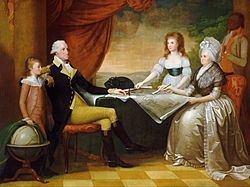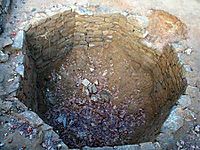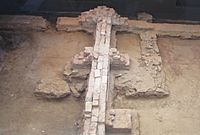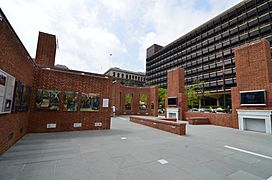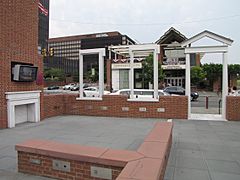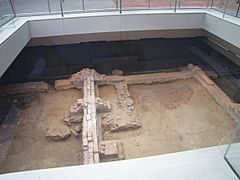President's House (Philadelphia) facts for kids
Quick facts for kids President's House in Philadelphia |
|
|---|---|
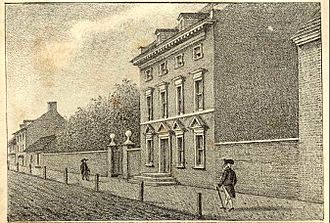
Third Presidential Mansion,
occupied by George Washington, November 1790 – March 1797. Occupied by John Adams, March 1797 – May 1800. |
|
| Former names | 190 High Street Masters-Penn House Robert Morris Mansion |
| General information | |
| Architectural style | Georgian |
| Address | 524–30 Market Street |
| Town or city | Philadelphia, Pennsylvania |
| Country | United States |
| Coordinates | 39°57′02″N 75°09′00″W / 39.9505°N 75.1501°W |
| Construction started | 1767 |
| Demolished | 1832 / 1951 |
| Client | Mary Lawrence Masters |
The President's House in Philadelphia was an important building in early American history. It served as the third official home for U.S. Presidents. George Washington lived here from 1790 to 1797. After him, John Adams occupied the house from 1797 to 1800.
This house was located near what is now Independence Hall. It was built around 1767 by a woman named Mary Masters. During the Revolutionary War, British General William Howe used it as his headquarters. Later, American General Benedict Arnold lived there.
Philadelphia was the temporary capital of the United States from 1790 to 1800. This was while Washington, D.C. was being built. Robert Morris, a wealthy supporter of the American Revolution, owned the house in 1790. He allowed President Washington to use it. Washington brought several enslaved people from his home in Mount Vernon to work in the house.
President John Adams also used this house as his official residence. He later moved to the new capital city. On November 1, 1800, Adams moved into the White House, which was still being finished. The Philadelphia President's House was later torn down. Today, a special memorial marks where it once stood.
Contents
The President's House: A Look Back
The President's House was a large brick mansion with three and a half stories. Mary Lawrence Masters built it in 1767. In 1772, she gave it to her daughter, Polly, as a wedding gift. Polly married Richard Penn, who was the lieutenant-governor of Pennsylvania.
Early History and Famous Guests
Richard Penn hosted important people at the house. These included delegates to the First Continental Congress. George Washington was one of these guests. Penn was chosen to deliver the Olive Branch Petition to King George III. This was a final attempt to avoid war with Great Britain. In 1775, Penn and his family moved to England.
During the American Revolutionary War, British General Sir William Howe used the house as his headquarters. After the British left, Benedict Arnold lived there. He was an American military governor. It was here that Arnold started secret communications with the British.
Later, Robert Morris, a famous financier, bought the house in 1781. He made many improvements to it. Washington stayed with Morris in this house during the 1787 Constitutional Convention. In 1790, Morris let Washington use the house as the President's official home. Morris then moved to the house next door.
President Washington lived in the house from November 1790 to March 1797. President Adams lived there from March 1797 to May 30, 1800. Adams then went to oversee the government's move to the District of Columbia. He spent the summer at his home in Massachusetts. He moved into the White House on November 1, 1800.
What Happened After the Presidents Left?
After President Adams left in 1800, the house became Francis's Union Hotel. In 1832, Nathaniel Burt bought the property. He changed the house into three narrow stores. He and his family owned these stores for over 100 years.
A famous merchant named John Wanamaker opened his first clothing store nearby in 1861. He expanded into the stores that were once part of the President's House. These buildings were later torn down in 1936 and 1951. This made way for Independence Mall. A public restroom was built on the site in 1954.
President Washington's Time in Philadelphia
President Washington, First Lady Martha Washington, and two of her grandchildren lived in the house. Their names were "Wash" Custis and Nelly Custis. The household staff included about 24 people. Eight of these were enslaved Africans. Four or five office staff also lived and worked there.
The house was a bit small for over 30 people. So, President Washington made some additions. He added a large, two-story curved section to the back of the house. This made the rooms much longer. He also built a long hall for servants. The stables were expanded, and a bathing room was turned into his private office.
Key Actions as President
- He helped set up the federal court system.
- He oversaw the creation and planning of Washington, D.C..
- He stopped the Whiskey Rebellion in western Pennsylvania. This was a protest against a tax on whiskey.
Enslaved People in the President's House
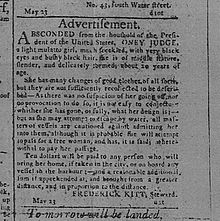
Washington brought eight enslaved people from Mount Vernon to Philadelphia in 1790. Their names were Moll, Christopher Sheels, Hercules, his son Richmond, Oney Judge, her half-brother Austin, Giles, and Paris.
Pennsylvania had a law for the gradual end of slavery since 1780. This law meant that no new enslaved people could be brought into the state. It also said that enslaved people could gain their freedom if they lived in Pennsylvania for six months.
Washington knew slavery was not popular in Philadelphia. He argued that he was a resident of Virginia, where slavery was legal. To avoid the Pennsylvania law, he would rotate the enslaved people. This meant they would not stay in Pennsylvania for six continuous months. He also made sure he himself did not stay for six continuous months. Joe (Richardson) was another enslaved person brought from Virginia in 1795.
Oney Judge's Story
Oney Judge was Martha Washington's personal servant. She was about 17 when she came to the President's House in 1790. We know a lot about her because she gave interviews to newspapers later in her life.
Oney Judge escaped to freedom from the President's House in May 1796. Philadelphia's free Black community helped her hide. The President's House staff placed ads in newspapers to try and find her. She was secretly taken on a ship to Portsmouth, New Hampshire. There, a friend of the Washingtons recognized her.
Washington tried to convince her to return, but she refused. She would only come back if she was promised her freedom. Martha Washington's nephew, Burwell Bassett, went to Portsmouth in 1798. He planned to take Judge back. But Senator John Langdon warned Oney, and she went into hiding. Bassett returned without her.
Hercules's Story
Hercules was the main cook at Mount Vernon. He came to the President's House in 1790 to run the kitchen. He asked for his 12-year-old son, Richmond, to come with him. But Richmond only stayed a year in Philadelphia.
For a long time, people thought Hercules escaped from the President's House. But new research in 2012 showed he escaped from Mount Vernon. This happened on February 22, 1797, which was Washington's 65th birthday.
Hercules left his daughters, Evey and Delia, and his son Richmond at Mount Vernon. He was reportedly seen in New York City in 1801. By then, he was free under the terms of George Washington's will. In 2019, a genealogist found records that suggest Hercules Posey died in New York City in 1812.
President Adams's Time in Philadelphia
Key Actions as President
- He helped build six new warships for the United States Navy.
- He established the modern United States Marine Corps.
- French ships seized over 300 American ships. This led to the XYZ Affair, where French officials demanded bribes. This caused the Quasi-War with France.
- He oversaw the completion of the White House and much of the United States Capitol.
Discovering the Past: Archaeology and Advocacy
As the year 2000 approached, plans were made for a new building to house the Liberty Bell. This building, the Liberty Bell Center (LBC), would be very long.
Archaeological Digs and Discoveries
2000 Archaeology
Archaeologists dug at the site of the LBC in late 2000. They found the bottom part of the President's House icehouse pit. Robert Morris built this amazing icehouse in the 1780s. It was a building without windows over a deep, stone-lined pit. The pit was about 13 feet wide and 18 feet deep.
In winter, workers would fill the pit with ice blocks from the Schuylkill River. This icehouse kept food cold for most of the year. The ice would last until October or November. The excavated icehouse pit was studied and photographed. Then, it was reburied under the floor of the Liberty Bell Center.
2007 Archaeology
Another archaeological dig began in March 2007. This dig focused on the back buildings of the house. A platform was set up for visitors to watch the work.
Workers found brick foundations from the three stores built in 1832. They also found that the kitchen had a basement. A section of the basement had a root cellar. An 1833 coin was found, possibly left by the builders. As they dug deeper, older foundations of the President's House appeared.
The dig uncovered the back wall of the main house. They also found much of the curved foundation of Washington's "bow window." This two-story curved section was part of the State Dining Room. It was designed by Washington himself. He used it to greet guests in a formal way. This curved design was an early idea for the famous Oval Office shape.
Hundreds of thousands of people visited the observation platform. The excavation closed in July 2007. A ceremony was held, and a bronze plaque was dedicated. It listed the names of the nine enslaved people who lived at the site.
President's House Memorial
The President's House: Freedom and Slavery in the Making of a New Nation memorial opened in 2010. It is an open-air display that shows where the original buildings stood. Visitors can see the remaining foundations. Some artifacts are also on display.
Signs and videos explain the history of the house. They also tell the stories of Washington's enslaved people. The memorial helps visitors understand the role of slavery in early American society. This memorial was a joint project by the City of Philadelphia and the National Park Service.
Images for kids


